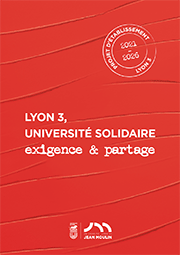AccueilRechercheProgrammes et productions scientifiquesThèsesThèses soutenuesThèses soutenues - 2006-2021Thèses soutenues - 2020
-
Partager cette page
- Recherche,
DHONDT née MARTRETTE Julie
Sous le signe du Tau : de la fraternité à l’abbaye, Saint Antoine et son réseau de dépendances dans les Alpes occidentales du XIe au XVe siècle.
Thèse en histoire religieuse, politique et culturelle, soutenue le 19 février 2020.
Marked by the Tau, is a research at the crossroads of religious, hospitable and social history. The lay fraternity which was born in Saint-Antoine under the impulse of two noblemen, Gaston and Guérin at the end of the eleventh century, made hospitality its primary vocation and relics of the saint, its essential purpose. Placed under the tutelage of the Abbey of Montmajour, this relationship did not hinder its expansion and the little fraternity was quickly at the head of an extensive network of dependencies. In a context of regularisation of the vita religiosa, Innocent IV transformed this first fraternal movement into a canonical order in 1247. Erected as an abbey and withdrawn from the tutelage of the Benedictines of Montmajour in 1297 by Boniface VIII, Saint-Antoine gradually became a political and religious power in the heart of the Dauphiné and Savoy. Between liturgical, devotional and hospitable practices, the canons of Saint-Antoine developed a specific propositum vitae, a middle path within the regular canons. Fully integrated into feudal society, their commitment to dauphins, kings of France and dukes of Savoy contributed to the emergence of new local aristocratic networks. Marked by the Tau is thus written the story of an original vocation struggling with the changes in feudal society.
Mots-clés : Antoine (saint), hospitalité, chanoines réguliers, Dauphiné, Savoie, réseaux, liturgie, pèlerinage, mendicité.
Keywords : Anthony (saint), hospitality, regular canons, Dauphiné, Savoy, network, liturgy, pilgrimage, mendicant.
Directeur(trice) de thèse : Alain DUBREUCQ
Membres du jury :
- M. Alain DUBREUCQ, Directeur de thèse, Professeur des université émérite, Université Jean Moulin Lyon 3,
- M. Daniel RUSSO, Professeur des universités, Université de Bourgogne,
- M. Laurent RIPART, Maître de conférences habilité à diriger des recherches, Université Savoie Mont Blanc, Chambéry,
- Mme MAGNANI Eliana, Chargée de recherches, CNRS Laboratoire de Médiévistique Occidentale de Paris,
- Mme CABY Cécile, Professeur des universités, Université Lumière Lyon 2.
Président(e) du jury : Cécile CABY







